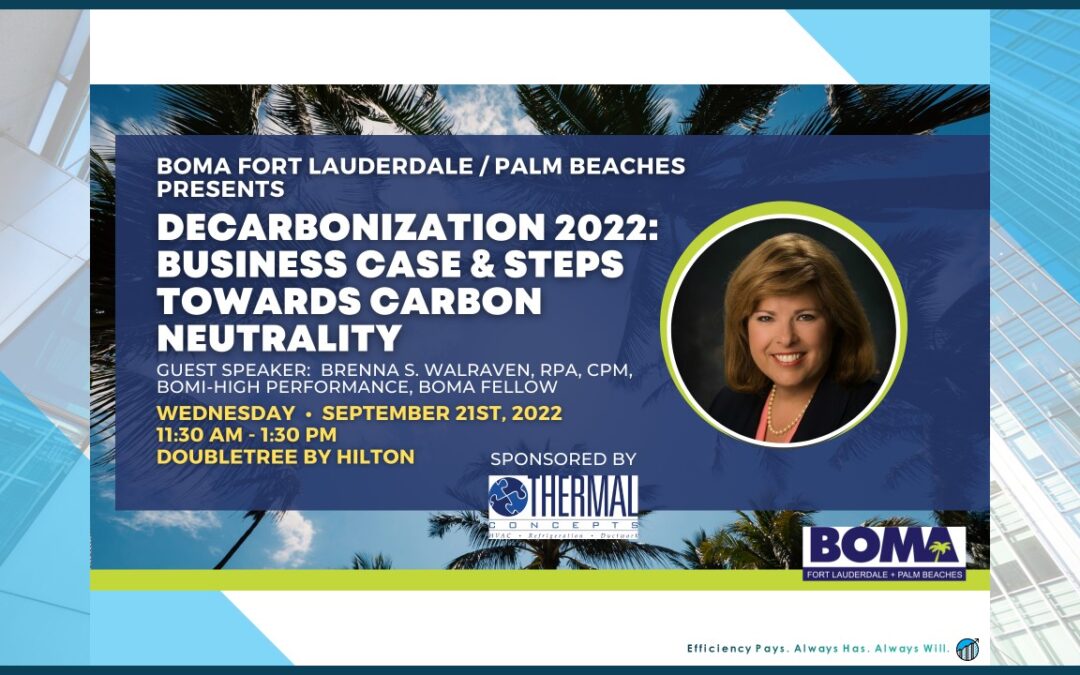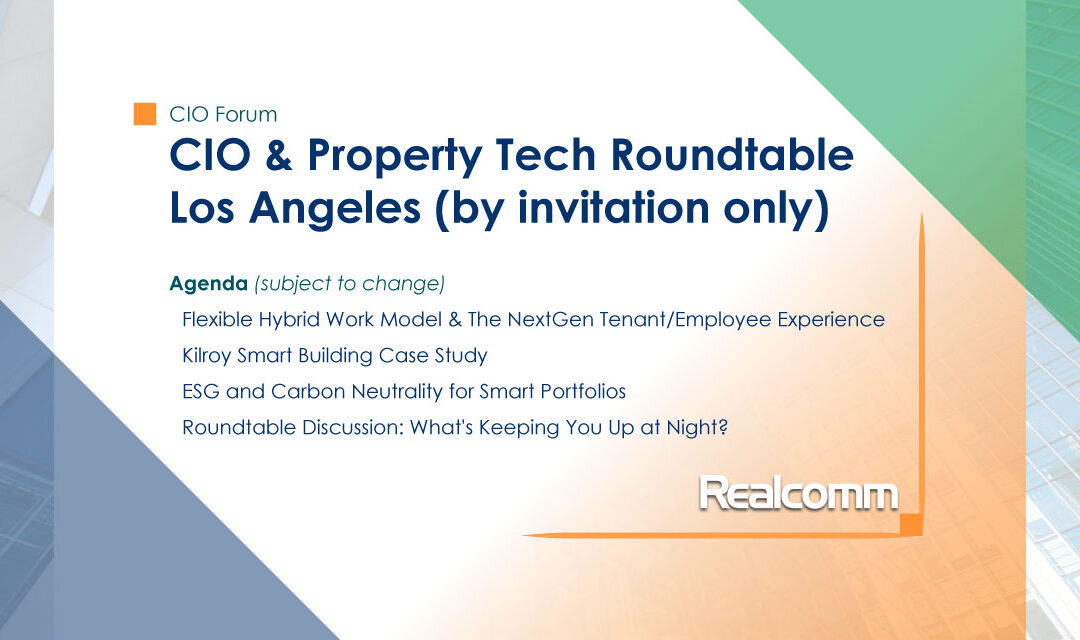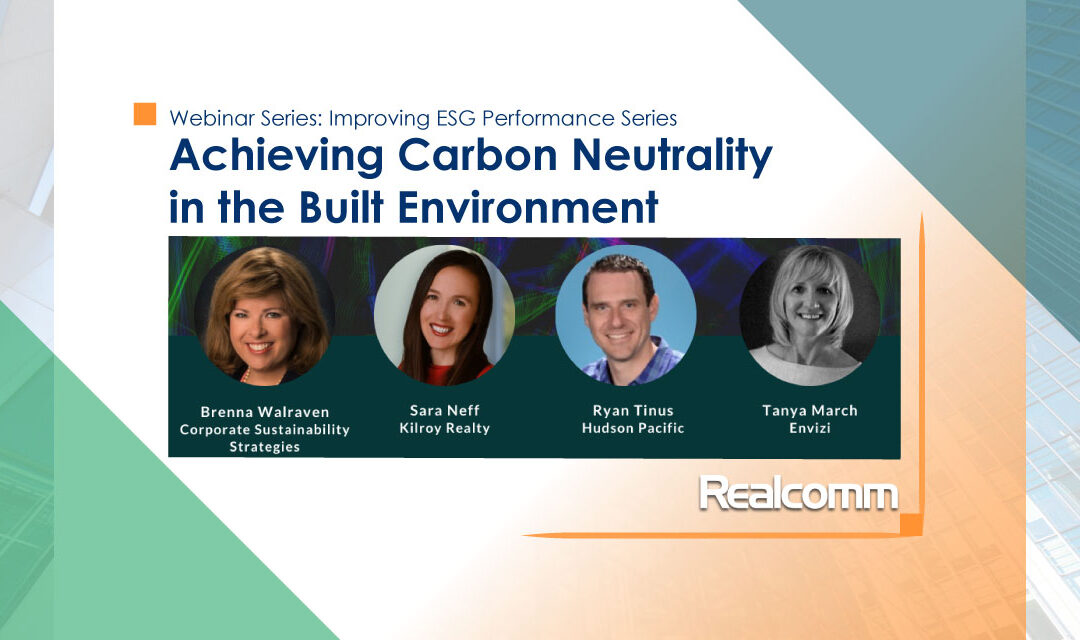
Aug 16, 2022 | Events, Homepage
Presented by BOMA Fort Lauderdale & Palm Beaches
Session Information
Investors are increasingly asking about it, and large corporate tenants are announcing commitments around carbon neutrality. The conversation is moving past just certifications and efficiency and into actual decarbonization. This presents building owners, operators and building engineers with an opportunity to cost-effectively develop a plan for net zero. Hear Brenna Walraven discuss the market context for the growing interest in ESG and decarbonization, provide high-level definitions for what carbon neutrality means, as well as basic steps and business cases for taking action.
Speaker
- Brenna S. Walraven, CEO, Corporate Sustainability Strategies (CSS)
When
September 21, 2022
11:30 AM – 1:30 PM
More Information & Registration
About BOMA
Building Owners and Managers Association (BOMA) Fort Lauderdale & Palm Beaches has 325+ members who own, operate, or service millions of square feet of office, industrial, medical office, retail, and mixed-use properties in Broward, Palm Beach, and Martin Counties. We understand that excellence in management directly impacts the quality and value of a commercial real estate asset.

Apr 7, 2021 | Events, Homepage
Program
Realcomm will be hosting a hybrid and “by invitation only” Commercial Real Estate CIO Roundtable on April 14 at a multimedia production studio near downtown Los Angeles. A select group of CIOs and senior technology execs will meet physically for discussions on a some of the most critical challenges facing our industry. In addition to attendees who’ll be “live” in the room, additional commercial real estate CIOs and senior technology execs from North America, Asia and Australia will join the conversation remotely via Teams.
Agenda
(subject to change)
Flexible Hybrid Work Model & The NextGen Tenant/Employee Experience
- Denise Taylor, President Global Technology, Legends Hospitality (moderator)
- Kimberly Bertz, SVP Workplace Services & Experience, Wells Fargo
- Keith Bereskin, VP IT & Building Operations, Healthpeak Properties
- Jim Whalen, SVP, CIO/CTO, Boston Properties
Kilroy Smart Building Case Study
- Bayron Lopez, Operational Technology Manager, Kilroy Realty
ESG and Carbon Neutrality for Smart Portfolios
- Brenna Walraven, President & CEO, Corporate Sustainability Strategies (moderator)
- Sara Neff, SVP Sustainability, Kilroy Realty
- David Hodgins, CEO, LA Better Buildings
Roundtable Discussion: What’s Keeping You Up at Night?
- Mike Goodwin, Director of Technology and CISO, Stockbridge Capital Group (facilitator)
When
Wednesday, April 14, 2021
12:00pm – 12:30pm: Networking
12:30pm – 12:45pm: Welcome & Introductions
12:45pm – 4:45pm: Presentations & Discussions
4:45pm – 5:15pm: Studio Tech Presentation and Tour
5:15pm – 6:15pm: Hosted Reception
Visit Realcomm CIO Forums for more information and to request an invitation.

Apr 7, 2021 | Articles, Homepage
By Brenna Walraven, President & CEO, Corporate Sustainability Strategies
Article published in Realcomm Weekly Briefing.
Leading companies that are seizing opportunities offered by zero-emissions mandates to generate business opportunities and value for their stakeholders was the focus of the most recent Realcomm webinar highlighting pathways to improving environmental, social, and governance (ESG) performance. In Improving ESG Performance and Part II: Achieving Carbon Neutrality in the Built Environment, industry leaders illustrated examples of how to use a planning process and smart building technologies to achieve energy savings and realize the value creation potential of ESG.
Commercial buildings contribute nearly 20 percent of U.S. greenhouse gas (GHG) emissions, so the building sector must be part of the solution to address climate change. For owners and operators, addressing the energy and carbon profile of their buildings is no longer a “nice to have” but a core business requirement. This evolution is driven by growing investor pressure, tenant preferences, and government regulation.
The Biden-Harris administration has signaled that agencies will view regulatory action and directing funding with a climate lens. For example, in March of 2021 the Securities & Exchange Commission (SEC) announced a task force focused on climate and ESG issues within the Division of Enforcement. State and local policy has been aggressive on energy and climate regulation. In total, 24 states and the District of Columbia have established economy wide GHG emissions targets, many of which align with a 50 percent reduction by 2030 and net zero (or nearly) by 2050. Jurisdictions are looking to frameworks like New York City’s Local Law 97 and the DC Clean Energy Omnibus Act, which build on mandatory benchmarking and disclosure of energy and/or emissions to set binding declining emissions caps for existing buildings.
Investors are also driving the imperative to address climate impact. The CEO of BlackRock, Larry Fink said, “Climate risk is investment risk” and noted that a fundamental reallocation of capital to sustainable investments has begun. Investors are no longer asking “Do you have an ESG program?” but saying, “To be investible, companies have to be taking action and transparently demonstrating performance.”
Increasingly, tenants are making net-zero commitments and requiring that their leased space meets these goals. Almost a quarter of global Fortune 500 companies committed to be carbon neutral by 2030 and are looking for buildings that align with these commitments, with transparent reporting that can be incorporated into their corporate climate reporting.
Leaders who have begun their progress toward carbon neutrality discussed their process in the Realcomm webinar Achieving Carbon Neutrality in the Built Environment.
Ryan Tinus of Hudson Pacific Properties shared his company’s Better Blueprint focused on achieving net zero carbon across all operations using a sustainable, healthy, and equitable approach. Sara Neff with Kilroy Realty shared CEO John Kilroy’s goal to be a leader in ESG and to help move the market towards carbon neutrality by announcing a commitment to carbon-neutral operations in 2018.
These successful leaders are following a best-practice process. The critical first step is an investigation of the portfolio to determine the approach, end goal, and timeline to reach climate neutrality. This includes determining emissions scope(s) and reporting boundaries, assessing the regulatory landscape and carbon intensity of the portfolio’s electric grid(s), and understanding incentives available for energy efficiency, electrification or onsite renewables, all of which contribute to a comprehensive carbon management strategy, appropriate end goal and milestones along the way.
The next step is developing a greenhouse gas/carbon inventory that sets a baseline against which to measure (and show progress), helps set realistic, achievable targets, and demonstrates ongoing credibility through tracking and reporting. The most straightforward framework is the GHG Protocol’s Corporate Accounting and Reporting Standard. The Science-Based Target Initiative works with companies to set carbon reduction targets that are aligned with the targets defined in the Paris Climate Accord.
After a GHG emissions inventory has been developed, opportunities to evaluate ways to reduce emissions can be assessed, prioritizing efficient operations and appropriate updating of inefficient systems and equipment as well as using innovations such as those described by Jon Schoenfeld with Buildings IoT and process approaches like those described by Chris Cayten, CodeGreen Solutions on the Realcomm webinar. These best practices coalesce around reducing emissions as the primary focus, maximizing the use of on- and off-site renewable energy sources, and then purchasing “offsets” for the remainder of the emissions as the “last step.”
Another important aspect of a carbon management plan is consistent measurement and tracking of key metrics. This is fundamental to reporting progress toward goals and assessing and adjusting strategy to stay on track. Staying abreast of developments in the investment community as well as in the regulatory space will inform the choice of platform(s), including the need for tools that comport with industry-specific standards, such as those developed by the Sustainability Accounting Standards Board (SASB) or the Task Force on Climate-related Financial Disclosures (TCFD). A best practice example of ongoing internal and external reporting and data management is described by Tanya March with Envizi on the Realcomm Achieving Carbon Neutrality webinar.
Next comes the fun part: announcing a commitment! Every week a CEO makes headlines for a bold climate commitment. At the same time, there is growing scrutiny about some of these commitments. “Long-range” goals that once seemed very far off are no longer so, and as 2030 draws nearer, the pressure to transparently demonstrate real progress will grow. Companies that invest in the foundational work of analyzing the opportunity, developing an accurate inventory, and setting realistic, achievable targets will protect themselves against reputational risk and potential negative financial impacts.
Executing on a climate neutrality commitment requires a combination of executing energy efficiency retrofits, incorporating renewable generation, considering opportunities such as end-use electrification, and investing in various offset schemes. It requires reassessing strategy as new technologies come online, grid energy decarbonizes, carbon offset prices change, and new value streams and business models emerge. A successful carbon management strategy will set a realistic and achievable “North Star” goal, utilize consistent and rigorous tracking and measurement, and follow the plan-do-check-act framework to stay on track.
Gone are the days when a plaque in the lobby was enough to attract tenants and investors. We are entering an era of rigorous and credible climate target-setting, tracking, and achievement. Companies that take climate risk seriously, and develop, track, and report climate neutrality goals will be at an advantage.

Feb 12, 2021 | Events, Homepage
The achievement of a balanced economic, social and environmental development is recognized as one of the major challenges the building industry is facing today. What is less clear is how building owners and developers can seize the opportunities offered by zero-emissions mandates and disruptive energy technologies to generate business opportunities and value for their stakeholders. In this series, industry leaders illustrate ideas and examples on how to use smart building technologies to achieve energy savings and realize the value creation potential from ESG.
Across the US, building owners and operators are tasked with making energy efficiency upgrades and/or decarbonizing their power supply to meet new emission reduction targets. This session discusses the impact of regulations on building operations and showcases portfolios that are committed to carbon neutrality.
Panelists
- Sara Neff, SVP, Sustainability, Kilroy Realty
- Ryan Tinus, Sr. Director, Engineering and Environmental Sustainability, Hudson Pacific Properties
- Tanya March, SVP, North America, Envizi
- Brenna Walraven,President and CEO, Corporate Sustainability Strategies
Date & Time
February 18, 2021
12:00 PM – 1:30 PM ET / 9:00 AM – 10:30 AM PT
Registration
Realcomm
About Realcomm
Realcomm was founded with the goal of bringing industry leaders together to discuss, demonstrate, and debate the latest innovations to impact our industry. For more information visit www.realcomm.com.




